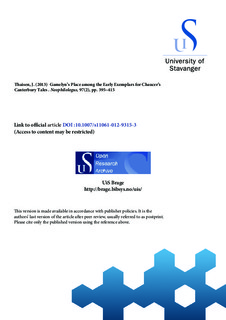| dc.contributor.author | Thaisen, Jacob | |
| dc.date.accessioned | 2014-10-24T12:43:00Z | |
| dc.date.available | 2014-10-24T12:43:00Z | |
| dc.date.issued | 2013-04 | |
| dc.identifier.citation | Thaisen, J. (2013) Gamelyn’s Place among the Early Exemplars for Chaucer’s Canterbury Tales. Neophilologus, 97(2), pp. 395–415 | nb_NO |
| dc.identifier.uri | http://hdl.handle.net/11250/224507 | |
| dc.description | The final publication is available at Springer via http://dx.doi.org/10.1007/s11061-012-9315-3 | nb_NO |
| dc.description.abstract | Application of standard techniques from natural language processing on N-gram models of spelling enables quantification of the similarity between Middle English texts despite their lexical differences. Three studies employing similarity metrics confirm that a scribe’s spelling always is biased in the direction of his exemplars. This bias opens up a window on the number of scribes behind the exemplars for a text executed in a single hand, when other variables such as authorship and poetic form are held constant. A fourth study addresses nine manuscripts of Geoffrey Chaucer’s poem the Canterbury Tales with early textual contents. A one-way ANOVA/Tukey’s Range Test shows that none of these manuscripts is based on exemplars written in more than three hands, when allowance is made for variation due to poetic form. The results point to unified exemplars for the full text as the normal format for the poem’s transmission. The discussion suggests that the final tale ordering found in the first manuscripts is a product of collaboration between the poem’s first two scribes, probably working after Chaucer’s death and spuriously adding the Tale of Gamelyn. | nb_NO |
| dc.language.iso | eng | nb_NO |
| dc.publisher | Springer Verlag | nb_NO |
| dc.subject | Chaucer | nb_NO |
| dc.subject | scribal copying | nb_NO |
| dc.subject | natural language processing | nb_NO |
| dc.subject | authorship attribution | nb_NO |
| dc.subject | Canterbury tales | nb_NO |
| dc.subject | manuscript production | nb_NO |
| dc.title | Gamelyn’s Place among the Early Exemplars for Chaucer’s Canterbury Tales | nb_NO |
| dc.type | Journal article | nb_NO |
| dc.type | Peer reviewed | nb_NO |
| dc.subject.nsi | VDP::Humanities: 000::Linguistics: 010::English language: 020 | nb_NO |
| dc.subject.nsi | VDP::Humanities: 000::Literary disciplines: 040::English literature: 043 | nb_NO |
| dc.source.pagenumber | 395-415 | nb_NO |
| dc.source.volume | 97 | nb_NO |
| dc.source.journal | Neophilologus | nb_NO |
| dc.source.issue | 2 | nb_NO |
| dc.identifier.doi | 10.1007/s11061-012-9315-3 | |
